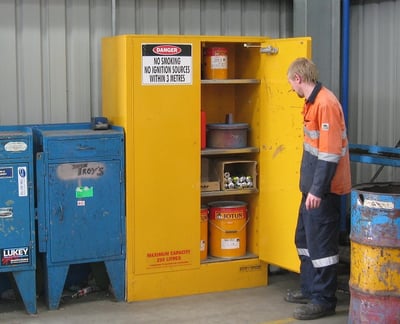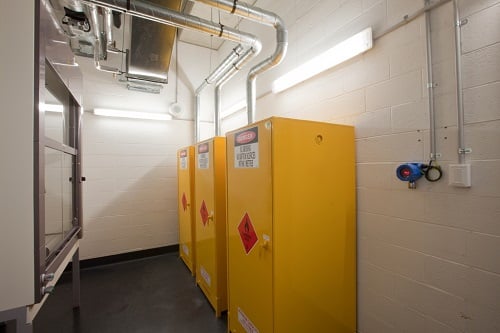Have you just bought a flammable liquids cabinet for your workplace? Or perhaps you’ve had had a safety cabinet for years, but you aren’t sure it’s 100% compliant? Whatever your situation, this blog will walk you through the essentials steps when installing a flammable liquids cabinet. We want you to install your flammable cabinet correctly, so you can comply with WHS Regulations and Australian Safety Standards.
1. Choose A Compliant Location
The first step in installing a compliant cabinet is to choose the right location.
To comply with AS 1940 – The storage and handling of flammable and combustible liquids you’ll need to make sure the cabinet is:
- At least 3 metres from ignition sources (power points, electrical equipment that could spark during discharge, electronics and gadgets that could create static electricity, hot work, industrial heat).
- Away from incompatible substances (compressed gases, flammable solids, oxidisers etc).
- Not blocking emergency exits.
- At least 10 metres from another aggregate quantity**
- Within a 10 second reach of a safety shower, emergency shower and first aid kit.
- Fitted with (or near) a Register of Hazardous Chemicals.
**AGGREGATE QUANTITIES: Ground floor — 850 litres per 250 square metres. Other floors — 250 litres per 250 square metres.
There are further requirements if your cabinet is over 250 litres. You must also consider these guidelines when installing or relocating your flammable cabinet.
Flammable liquids cabinets over 250 litres
- Never installed against a common wall.
- Not installed in a public building, accommodation house, hospital/aged care/medical facility or school.
- Only installed on the ground floor (or any floor that has direct access to the street).
IMPORTANT: Our team always recommend conducting a risk assessment on your flammable liquids (and other hazardous chemicals) before purchasing and installing a cabinet. Download our free eBook Essential Considerations When Storing Flammable Liquids Indoors to learn more.
2. Level The Cabinet
Once you’ve decided on the location for your safety cabinet, you must ensure that the surface is level — and the cabinet’s not resting at an angle.
There are three important reasons for this:
- The cabinet needs to be stable — being on an angle can unbalance the structure making it vulnerable to being knocked over.
- If the base of the cabinet isn’t level and you fill it with heavy fuel drums this can stop the doors from closing properly. If the doors are prevented from closing automatically the cabinet is no longer compliant with AS1940.
- The shelving in the cabinet is angled to ensure that leaks and spills are immediately directed into the lower compound. If the cabinet is not level this will interfere with the compliance of the spill containment facilities.
3. Segregate Flammable Cabinet from Incompatible Goods
Now that your flammable cabinet is situated in the right location and resting on an even, level surface, it’s time to think about how you’re going to use the cabinet.
As the name suggests, flammable cabinets are designed to store Class 3 Flammable Liquids. We know that this sounds a little obvious, but make sure that nothing but flammable liquids are placed in the cabinet.

Installing your cabinet correctly is a key part of your compliance obligations.
Storing incompatible substances together can cause fires, explosions and dangerous chemical reactions. To determine your segregation requires, you must identify all chemicals that you carry at your workplace as per the information on the Safety Data Sheet, determine their segregation requirements and then implement risk control measures.
REMEMBER: The distance you segregate your flammable cabinet from other cabinets holding incompatible substances should be determined by your own fire and risk assessment.
For compliance and safety please make sure that you:
- Remove cardboard cartons, excess packaging and other combustible materials before placing flammable liquids in the cabinet.
- Don’t load the cabinet past its approved capacity rating.
- Ensure drums, tins and containers are standing upright on the shelves — and nothing is placed in the lower compound (which is designed to catch and contain leaking chemicals).
- Close the lids and wipe down containers before placing in the cabinet.
- Make sure containers are fully inside the cabinet and not preventing the doors from closing.
- Ensure the area is well-lit and that all signs, stickers and markings can be easily seen when the doors to the cabinet are closed.

Flammable liquids cabinets won't offer safety and compliance if your staff don't understand how to use and maintain them.
3. Implement Good Housekeeping
Housekeeping isn’t just something you do when it’s required at home. Your safety cabinets rely on regular housekeeping practices to maintain compliance.
Once your cabinet is correctly installed and stocked with Class 3 Flammable Liquids, you’ll need to implement some new housekeeping procedures.
Your housekeeping practices should include:
- Prohibiting workers from carrying out hot work like welding and grinding near the cabinet.
- Restricting access to the area.
- Keeping the general vicinity free of combustible materials (eg, boxes, pallets, refuse, debris).
- Not allowing workers to bring personal electronics, incompatible chemicals, or vehicles near the cabinet.
- Never using the top of the cabinet as a decanting area.
- Never propping the cabinet open.
- Never move or relocate the cabinet with chemicals inside.
- Putting orders away immediately and not leaving them on the ground next to the cabinet for days (common practice).
4. Train Workers and Supervisors
As you have probably experienced in your own workplace, safety cabinets can quickly fall into disrepair if you don’t train your staff, contractors and supervisors to use them properly.
Consider including the following in your flammable cabinet training program:
- Hazard awareness, locations of cabinets, restricted activities.
- How to load the cabinet correctly, including approved capacity, segregation, opening and closing, adjusting shelving.
- How to safely clean the cabinet and clear the spill sump.
- Correct housekeeping practices for inside and around the cabinet.
Your installation and training program should also have scope for managers and supervisors. Afterall, they are the staff members that enforce housekeeping and operational procedures. It’s a good idea to build responsibilities into job descriptions — and hold people accountable for unsafe work practices.
5. Carry Out A Post-Installation Check
A few weeks after you’ve installed your flammable cabinet, you should carry out a post-installation check. By following this checklist, you’ll be able to make sure that the cabinet has been properly installed and is also being used correctly by your staff.
Your post-installation check should include:
- Ventilation issues: have workers complained of fumes near the cabinet?
- Prohibited activities: are workers carrying out repairs next to the cabinet?
- Correct usage: are mixed hazard classes being kept inside the cabinet? Is it overloaded?
- Structural integrity: is the cabinet on a level surface? Was the cabinet dented or damaged during installation in a way that could impact the integrity and safety rating of the cabinet?
Is Your Flammable Liquids Cabinet Installed In A Compliant Manner?
As we’ve detailed in this blog, there’s a range of steps that you can take to make sure that your flammable cabinet is installed, used and maintained to meet the requirements of WHS Regulations and Australian Standards. But, there’s still more to learn. If you’d like to find out more about selecting and installing flammable cabinets, we invite you to download our free eBook Essential Considerations When Storing Flammable Liquids Indoors. In this helpful guide, we’ll explain how you can better understand the flammable liquids hazards at your workplace and how you can assess your compliance obligations. Our eBook also contains our 4-Step risk management methodology, IDENTIFY - ASSESS - CONTROL - SUSTAIN, which you can easily implement in your business. Access our guide today by clicking on the image below.
Joining the team as a Dangerous Goods Storage Consultant, Melissa Hampton became Storemasta's Marketing Manager in late 2021. With extensive knowledge and experience in chemical compliance, Melissa is responsible for leading the Marketing team and helping shape their marketing strategy. In her spare time, you can find Melissa hiking, swimming and enjoying the great outdoors in beautiful north-west Tasmania.

